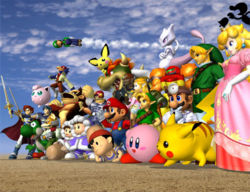Portal: Super Smash Bros.

| |
| Super Smash Bros. | |
| Developer | HAL Laboratory |
| Games | List of all games |
| Debut | Super Smash Bros. (1999) |
| Gallery | GH Gallery |
The Super Smash Bros. series brings together several Nintendo franchises into one four-player action-packed fighting game. Fighters, stages, and items come from some of Nintendo's best loved properties (and in the third installment, Super Smash Bros. Brawl, characters from other video game companies). Super Smash Bros. combines fighting, action, and platforming all into one seamless package.
History[edit]
Super Smash Bros. originated from a prototype fighting game developed by Satoru Iwata and Masahiro Sakurai known as Kakuto-Geemu Ryouh (which translated to Dragon King: The Fighting Game) during the spare time they had between projects. Iwata worked on planning, specs, design, modeling and movement while Sakurai worked on the programming by himself. Sakurai aimed to deviate from standard two-dimensional fighting games and make an interesting four-player fighting game which offered a new experience with each play.
The game came to feature Nintendo characters when Sakurai realized the difficulty of setting up the game's atmosphere when playing a fighting game on a home console. This led Sakurai to ask for permission to use Nintendo characters. This led to the game becoming the first Super Smash Bros., released for the Nintendo 64 in 1999. The Final Smashes that would later be featured in Super Smash Bros. Brawl were actually originally planned for the first game, and in fact voices were recorded for the Final Smashes during the development of Super Smash Bros. that were later used in Brawl. The original Super Smash Bros. featured a roster of eight characters and four hidden characters all from a variety of franchises from the well-known Mario Bros. and Zelda series to the more obscure Earthbound and later Fire Emblem series.
The success of the first Super Smash Bros. led to a sequel for the Nintendo Gamecube, known as Super Smash Bros. Melee. This game vastly improved on the original, with Sakurai planning it as if it were the last Smash Bros. game. This game expanded the roster to 25 characters, expanding on franchises already represented (by adding characters such as Princess Peach and Bowser from the Mario series, and Princess Zelda and Ganon from the Zelda series) while adding more franchises with the inclusion of characters such as the Ice Climbers and Fire Emblem characters. The only problem accompanying this was that various hidden characters did not have original movesets but were "clones" of other characters' movesets. Melee also expanded on single player gameplay experience by adding the Adventure Mode, which contained several side-scrolling stages, as well as the Event Mode. The game also aimed to be a guide to everything Nintendo with hundreds of special trophies of various things related to Nintendo with written descriptions.
Following the success of Melee, Sakurai wound up developing Super Smash Bros. Brawl for the next console, the Nintendo Wii. Brawl was a much more ambitious game which added more fighters (while dropping a select few from the Melee roster) and even began to add several third-party fighters in the form of Konami's Solid Snake and Sega's Sonic the Hedgehog. The game also boasted an impressive single-player story mode called The Subspace Emissary which combined elements of sidescrolling platformers with the Smash Bros. fighting style. Subspace Emissary featured a variety of unique enemies, as well as some bosses from other Nintendo games such as Ridley and Petey Piranha. There was an entire unlockable system; in addition to the trophies, there were stickers which could power up characters in Subspace Emissary as well as collectible CDs which contained music from various classic Nintendo games. Other characters who weren't playable wound up being included as "Assist Trophies" that could temporarily aid in battle. The gameplay mechanics were altered to emphasize fun over skill, including the addition of special Final Smash moves, and the game was the first in the series with online gameplay.
Although Sakurai had initially intended for Brawl to serve as the grand finale for the Super Smash Bros. series, he and Project Sora later worked with Nintendo in developing a pair of new installments that were created simultaneously for the Nintendo 3DS and Wii U in 2014. These installments were both simply titled Super Smash Bros.. They both featured the same roster of fighters and basic gameplay, but each game had some unique features and modes, in addition to featuring different stages. This game brought in some additional third party characters such as Mega Man and Pac-Man, and it also incorporated DLC into the series, complete with a series of additional playable fighters that were released for purchase in the months following the games' release.
The sixth installment for the Smash Bros. series was Super Smash Bros. Ultimate, released for the Nintendo Switch in 2018. This game brought back every character from Smash Bros. history and modified their movesets while adding some new characters.